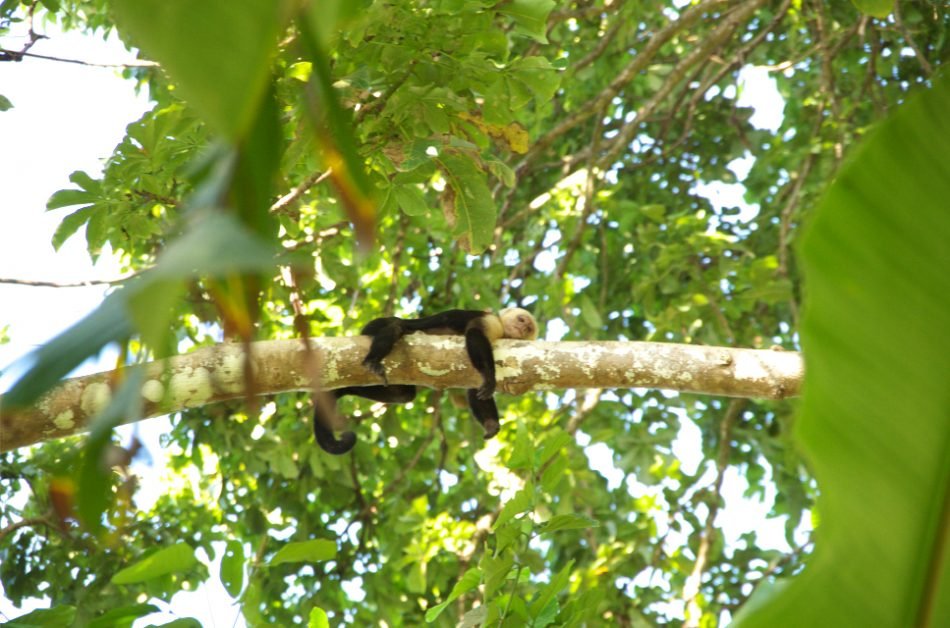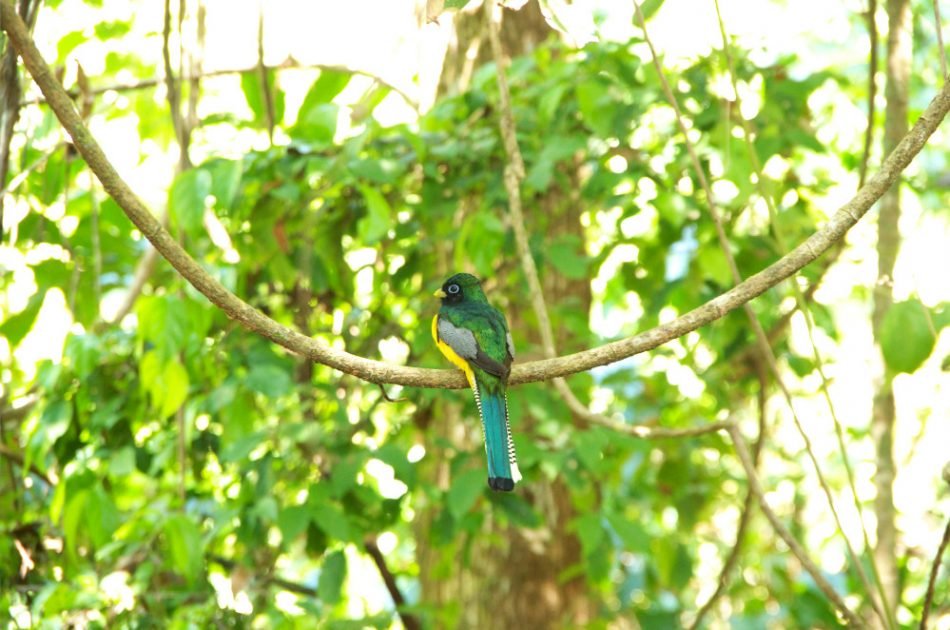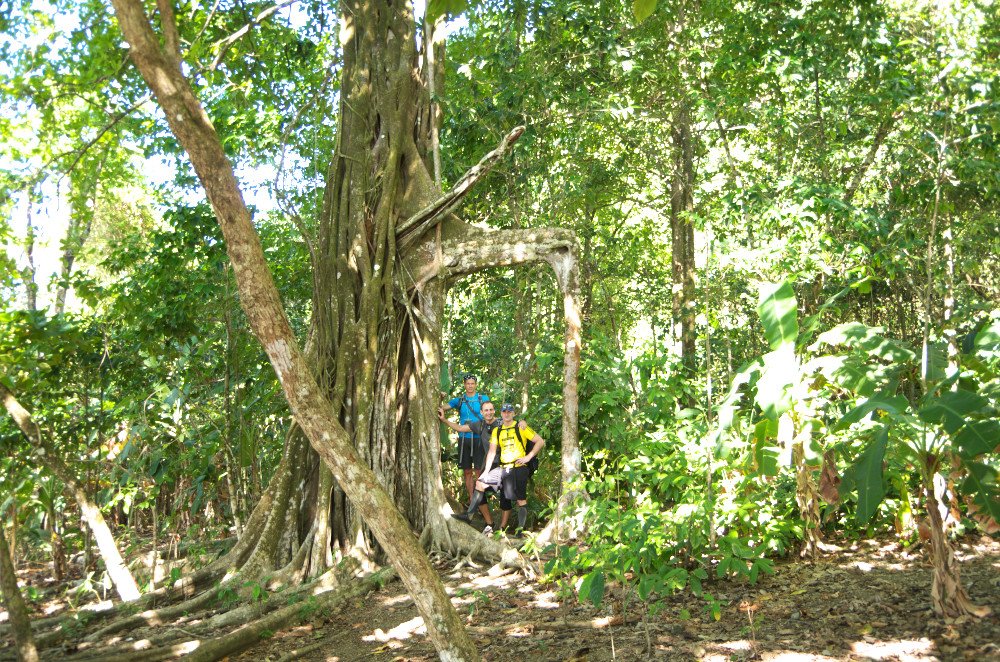Read the part I and part II of this off the beaten path escape travel story here and here.
Contents
Part 3: Hiking trail in Corcovado National Park
Corcovado
Our epic jungle hiking trail started at the small Carate village in the very south of Osa Peninsula. It is around 43 km (27 miles) two-hour drive on a bad road from Puerto Jimenes.
The most popular is the two-days hiking trail in Corcovado National Park. In Corcovado, you can camp only in ranger stations. Thus, we had to reach Sirena Ranger Station by any means. The station is in the middle of the jungle. This is a 22 km (14 miles) long hiking trail (one way) along the Pacific beach and through dense jungle. You can also reach the station by small plane or by boat. Yet, hiking makes this trip truly authentic. It is backpacking experience of a lifetime. The hiking trail is in a wild area and requires some preparation before you go there.
Corcovado National Park is one of the most biodiverse places on Earth. It takes the large part of Osa Peninsula – around 54 thousand hectares (133 thousand acres).
There are no economic activities in the park, and nature can develop in its own course there. The park is an important nature conservation area in Costa Rica. It is an important place for environmental education, scientific research, and ecotourism.
Corcovado is often called Costa Rica’s Amazon jungle. It is mostly covered with lowland rainforest.
Dense jungle hides many snakes and frogs. There are 4 species of monkeys. We saw the most common Howler monkey, Spider monkey, and White-Faced Capuchin monkey on our way. You can also meet the sloths there. They are called osos perezosos or “lazy bears” in Spanish because of their famous slow tempo of life. At least 10,000 species of insects include 100 species of butterflies. You will find tapirs and, if lucky, small wild cats Margays and even jaguars here.
The park has countless species of birds. Countless in this case means more than 400, including 16 species of hummingbirds. There are large American crocodiles that love salty waters. So, stay away from the rivers, where they meet the Ocean. Sharks foray into the coastal waters. Finally, all this is no way an exaggeration.
Getting ready for the hike
If you want to enjoy truly wild off the beaten path hiking trail, this is the one for you. You can go for this hike only together with an experienced guide. We got a local man named Santos.
A day before the hike we had to buy the food. The challenging task was to get food that has lots of calories but less weight. We had some sharp disputes in a local grocery shop how many canned tuna and beans we should pack in our backpacks. I must say that it was not that easy to decide on the right amount. Nobody wanted to starve. Neither anybody was excited about carrying around excessive weight. After all, we were about to go to humid and hot lowland jungle.
You are also obliged to carry your own trash because nothing can be left in the park. This is a good example of sustainable tourism, which I can only support.
Finally, we came to a mutual agreement. At least we thought so at that moment. We found the golden middle way between my “We have to take as less as possible” and Janis’ “Are you crazy? It’s not enough!”. We shared the weight among our backpacks and were ready to leave early next morning.
Morning adventure on the way to hiking trail
Next morning we understood that we have taken a good decision to go to Carate with our own rented car. Another option was to join the transport kindly offered by the local tour company. Yet, then we would be trapped in a livestock truck for 20 kilometers before tiring 22 km hike. Not surprisingly the road was very curved and rich with pitfalls. Thus, first, getting with our car to Carate was faster. Secondly, it was much better for our health. Yet, if I would travel alone I would probably opt for a truck.
We left in early morning well before the midday heat. Early morning is also a good time if you want to see animals in the jungle. During the daytime, they are hiding from the heat somewhere in the forest’s shadows.
That morning we met an anteater (Northern Tamandua). He or she quickly disappeared into the jungle. Our guide Santos apparently wanted to present his competence at the drop of a hat. He was eager to show, how well he knows surroundings and the habits of the local creatures. In a fraction of a second Santos jumped out of the car and disappeared somewhere in the jungle. Besides, he did it as vigorously as the anteater did just a moment ago.
For a minute or two, we heard only the sounds of breaking branches.
I must say Santos was an incisive persecutor. Anteater obviously lost any hope to escape and climbed on a top of the closest tree. Finally, Santos showed up from the bush too. He looked like a bush himself covered with all kind of different sticky vegetation parts. Yet, he could be hardly prouder of his achievement. Santos presented us the anteater with a smile on his face. This was in the way a chief of the art gallery would present a new chef-d’oeuvre to mainstream plebs.
At that moment I had a bad glimpse. What if we will get such a performance after each anteater we would meet on our way? Our hike would probably last for a week or more. Janis would die from hunger, first making me feel the most miserable friend in the World. Luckily we did not meet any anteater anymore. During the hike, Santos disappeared in the jungle alone only more time. We even thought that he has left us. Yet, he showed up and showed us a tapir that was sleeping next to the river. It was a really nice surprise.
On the hiking trail into the wilderness


I’ll be very honest. We all three love sports, but the hike was a great challenge. The hiking trail led across the dense jungle and along the wild beach with dark volcanic sand. A combination of heat and high humidity is an added level of difficulty in this hike. The only places that gave some coolness are the small rivers on the way that we had to cross. The water in the rivers was fresh and cool.
Dense leaves of the trees in the jungle give you shelter from the sun but not form the heat and humidity. Walking in the jungle was easier than on the sunny beach. The dark volcanic sand is soft and heats up in the sun almost like the pan heats on the stove.
Yet, what you see in Corcovado compensates all the difficulties. The many species of tall Ficus trees and wooded lianas make the forest fairy-tale alike. All the colorful birds, loud monkeys and amazing views of Pacific coast stop your breath for a while. During the hike, we were several times bothered by funny Racoon-like animals. They crossed our path without any respect or fear. These are White-Nosed Coati families. All this is what makes this hike into the “once in the lifetime” experience.


Santos also showed us the poison-dart frogs or dendrobates. These are very colorful and very poisonous little frogs. They are native to tropical Central and South America. Local Indians use the poison on the skin of these frogs to make their darts lethal for the pray.
We also ran on several skeletons of large whales on our way. They were silent witnesses that nature is not merciful even to the biggest of us.
Crossing the river
After seven hours we were close to our target – Sirena Ranger Station. We had to cross another wider river, where we decided to take a swim. Santos did not join us though. “This is not my shower day”, he replied and grinned for a moment.
The river was not deep because there was a low tide in the Ocean. The water level was a little higher than our knees. Thus swimming was more like bathing there. Yet, we enjoyed it so much that did not pay much attention to the surroundings.
We left the water not without hesitation. And now it was the time for our guide to have a little fun. He called Janis first and passed a binocular pointing to a distant place some 100 meters (110 yards) from us. There was a huge American crocodile basking in the sun! With all the respect I could not see a trait changing in Janis’ face at that moment. We all had a nervous laugh about the very dark sense of humor Santos employed. Then he added that American crocodiles attack people very rarely. Thus, there was actually no reason for any worry. “Rarely” does not mean “never” I muttered in Latvian, but decided that our guide knows what he does.
Later I read that large American crocodiles kill on average one person each year in Costa Rica. Some tourists are crazy enough to swim in rivers, lagoons, and lakes, where the crocodiles occur. There are also aggressive Bull sharks often feeding in the salty deltas of rivers. Thus, it is important to choose the best timing for crossing the rivers, and it is normally low tide.
Sirena Ranger Station
Sirena Ranger Station was a special place at the end of our hiking trail in Corcovado. It is possible to get there with a small plane that lands on the runway that I would rather call a bumpy country road. You can also get there by boat from Drake Bay. Lastly, you can be crazy enough to go there on foot from Carate village as we did.
Be ready for “special” conditions when you are there! You will sleep on the wooden platform terrace. There are two options. One is to sleep on an old yoga pad simply under a mosquito net, what I did. Another is when you get a tent, which is also set on the same wooden platform. Edgars and Janis were “lucky” to get a tent. It might seem that the second option is better, but it is not. It is pretty hot in the tents in that climate. Thus, sleeping in “fresh” air under the mosquito net was actually a much nicer experience. Yet, the padding was thin in both cases. Do you have problems with back or sleeping on hard surfaces? Too bad for you! Yet, this is just one or several nights. Everyone can do it.
We were tired and hungry. Thus, our feelings were very different depending very much on the temper of each of us. Our individual viewpoints on the situation were also quite different. They varied from different levels of irritation to relaxed smiling. I will not specify which of these emotional forms belonged to whom. The experience was amazing because we were in the middle of nowhere. The conditions were rustic and they showed how strong we are as one travel team.
Santos surprised us warning that personal belongings sometimes “disappear” in the station. First, I got confused. Who steals in the middle of the forest? I looked around more carefully. None of the people around looked very suspicious. It might be that some hippies there might have a bit of chill-out mood. It would be like “Hey, dude, this looks like a useful thing on the floor right there! I should probably take it for when I would need it!” Take care of your belongings I am sure nothing bad will happen.
There are strict rules once you get to the station. You may not leave the station as soon as it gets dark. This is after 5.30 p.m. The jungle around is rich with biodiversity. There are also lots of venomous creatures like snakes and spiders. They become active when it is not that hot outside anymore. This is usually in the dusk and dawn. Should you decide to go for a walk in these hours, it is possible that this can become your last walk. Nobody wants to take these risks. Besides, it is almost impossible to get emergency medical help in this remote area.
Alcohol is not allowed in the station too.
There is a beautiful beach around 800 meters from the station, but you cannot swim there. The Pacific coastal waters here are cunning. There are strong rip currents and sharp cliffs. The waters are also rich with aggressive Bull sharks and crocodiles.
A diesel generator produces electricity in the station. Thus they turn on lights at 6.00 p.m. and turn them out at 8.00 p.m. sharp. After this, it gets so dark that you do not have any other choice than going to sleep.
It is funny that they have Wifi in the station but they don’t have any mobile coverage. Luckily you do not need any of them. Instead, you feel happy that, finally, nobody can reach you.
Ranger station serves the joint dinner that was delicious, or we were so hungry that we thought so. After the dinner, we sat on the terrace and enjoyed the various jungle sounds. The many jungle eyes stared at us from the dark trees reflecting the beams of our headlamps. It was a feeling of another reality again. Amazing, how nature changes our perspective on time and reality. It all becomes one with us.
Sleeping on the wooden floor does not need any specific comments. The same is for looking the toilet in the middle of the night and meeting a toad of a size of handball on my way.
 Leaving the wild paradise
Leaving the wild paradise
We woke up at 4 a.m. to start our way back to Carate before it gets hot again. Do you want to get an idea of the sounds on the hiking trail in Corcovado at such an early morning? Imagine that tens of Baskerville dogs surround you, all howling at the same time! These are so-called Howler monkeys.
We went back, and the Pacific coast was totally different as it was when we came here. It was high tide now and most of the beach was underwater. Thus, in some places, we had only a narrow stripe of land to get ahead. Yet, it is the same hiking trail.
This was not that long but definitely the most incredible hike in the jungle I have had so far. Corcovado National Park is a pristine jewel of unspoiled nature. There are few such left today on the Earth.
This hike is not for those who need comfort. You also need to be reasonably fit to go there and like wildlife. Yet, the most challenging journeys are the most rewarding, and this was one of them.
Read the part IV and part V of this adventure story here and here.


